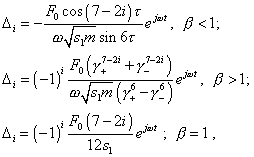| V.2 No 2 | 31 |
Investigation of elastic constraint non-linearity |
|
|
|
| 3. Solution seeking technique
In order to identify the way of seeking the solution for (3), note that in case s3 = 0 this system reduces automatically to that linear whose solutions we know [10]: |
|
|
(6) |
| where i = 1, 2, 3 , | |
|
(7) |
This gives us a possibility to seek exact analytical solutions for each separate harmonic in a simple way; when seeking the solution, we will explain the features of this way for each step corresponding to the seeking of a particular harmonic. In order to determine the direction of step-by-step finding the
harmonics, let us draw our attention to the following detail. If we substitute, e.g., the
periodical solution (at This feature gives us the reason to seek the general solution as a series beginning with the fundamental harmonic corresponding to the external force frequency |
|
|
(8) |
where As we see, the absence of the condition of non-linearity
smallness in the elastic constraints has led us to the essential change of the form of the
sought solution. In particular, the parameter |
|
|
(9) |
| By its shape, (8) looks more like an expansion of a
complex function into the Fourier series that usually is inapplicable in solving the
nonlinear mechanic problems by the conventional methods. But with it the summation in (8)
is carried out only in the positive values of p, and even the zero term is
absent. Should we actually seek the solution in the form of Fourier expansion, we would
not may narrow the summation region without limiting the generality of the solution.
However, as we will show below, the coefficients |
|
|
(10) |
| the coefficients ak and bk are real numbers, and the coefficients ck are complex numbers that are determined from the equality | |
| (11) | |

